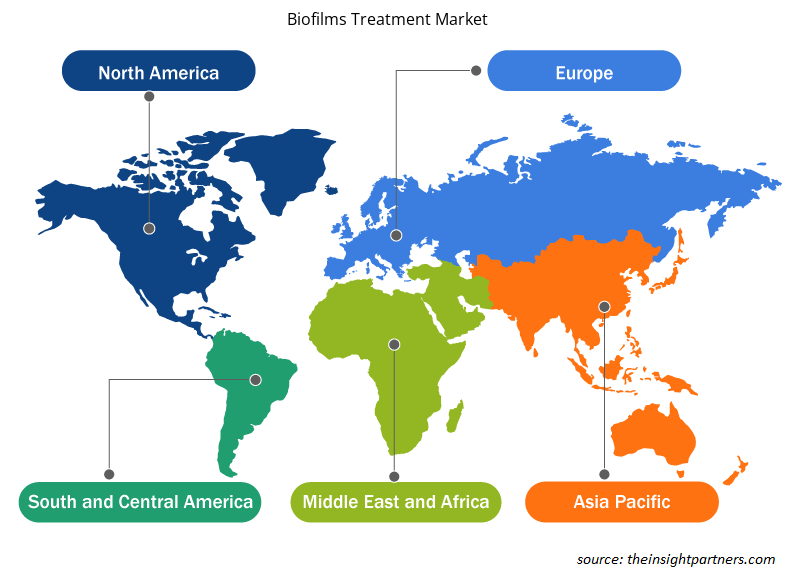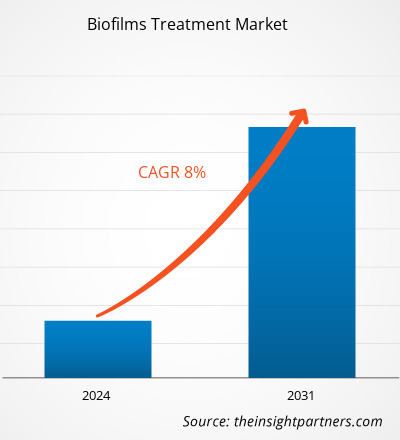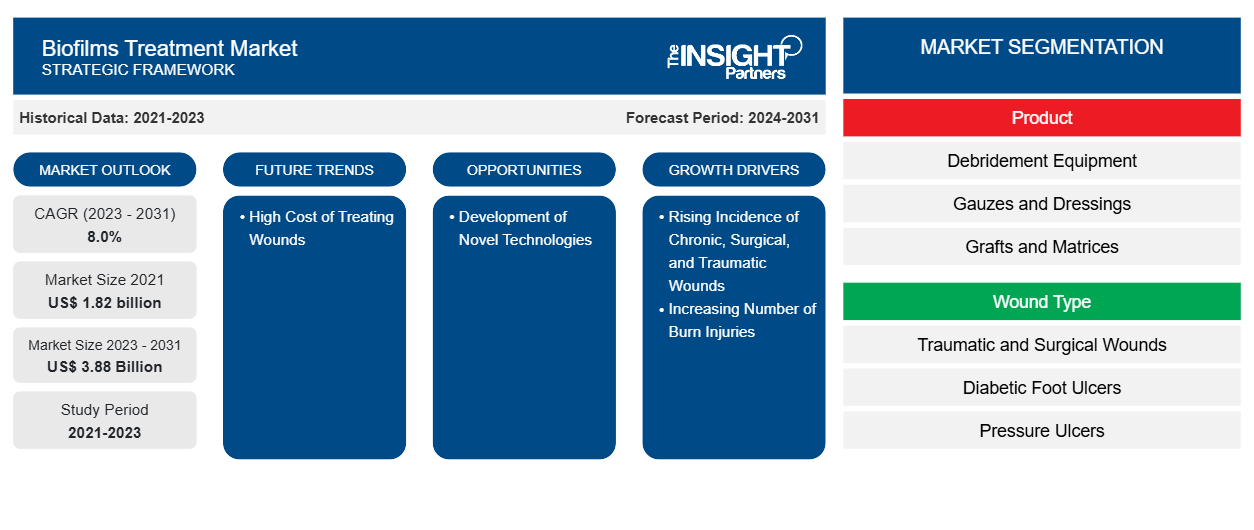Der Markt für Biofilmbehandlungen belief sich 2021 auf 1,82 Milliarden US-Dollar und soll von XX Milliarden US-Dollar im Jahr 2023 auf 3,88 Milliarden US-Dollar im Jahr 2031 anwachsen. Der Markt wird voraussichtlich zwischen 2023 und 2031 eine durchschnittliche jährliche Wachstumsrate (CAGR) von 8,0 % verzeichnen. Wachsende strategische Entwicklungen wie Produkteinführungen und Produktzulassungen sowie die Entwicklung neuer Technologien werden voraussichtlich weiterhin wichtige Trends auf dem Markt für Biofilmbehandlungen bleiben.
Marktanalyse zur Behandlung von Biofilmen
Die zunehmende Häufigkeit von Wunden und Infektionen und die Verbreitung von Biofilmen auf medizinischen Geräten erhöhen die Nachfrage nach Biofilmbehandlungen und beflügeln damit den Markt weltweit. Darüber hinaus ist die zunehmende Verbreitung von Biofilmen ein zusätzlicher Faktor, der das Marktwachstum im Prognosezeitraum voraussichtlich steigern wird. Einigen Studien zufolge sind Biofilme in 60 bis 100 % der Proben chronischer Wunden vorhanden. Dieser Faktor steht für die schnellere und räumliche Ausbreitung von Biofilmen in chronischen Wunden, die eine optimale Behandlung der Biofilme erfordern würden. Technologische Verbesserungen, die Entwicklung neuartiger Produkte und der Eintritt neuer Akteure in die Biofilmbehandlung werden den Markt wahrscheinlich auf globaler Ebene erweitern. Faktoren wie die zunehmende Zahl von Infektionen im Zusammenhang mit Biofilmen und Antibiotikaresistenzen sowie die hohen Kosten und die geringe Akzeptanz fortschrittlicher Wundpflegeprodukte sind ebenfalls potenzielle Hemmnisse, die das Gesamtwachstum des globalen Marktes für Biofilmbehandlungen behindern.
Marktübersicht zur Behandlung von Biofilmen
Steigende Gesundheitsausgaben, eine alternde Bevölkerung, die anfälliger für chronische Wunden ist, neue Produkteinführungen und günstige Erstattungsszenarien treiben das Marktwachstum voran. Regulierungsbehörden erkennen zunehmend die Auswirkungen von Biofilm-bedingten Infektionen auf die öffentliche Gesundheit. Es werden strenge Vorschriften und Richtlinien entwickelt, um Biofilm-bedingte Infektionen zu verhindern und zu behandeln, was die Nachfrage nach konformen Biofilm-Behandlungslösungen erhöht. Unternehmen streben aktiv nach technologischen Fortschritten und Innovationen, um die Biofilm-Behandlung über traditionelle Methoden hinaus zu verbessern. Diese Innovationen können die Entwicklung fortschrittlicher Wundverbände mit verbesserten antimikrobiellen Eigenschaften, die Integration intelligenter Materialien zur Erkennung und Bekämpfung von Biofilmen und die Erforschung gezielter Arzneimittelabgabesysteme zur Reaktion auf in Biofilmen eingebettete Bakterien umfassen. Darüber hinaus laufen Forschungsanstrengungen, um neue Technologien wie Biotechnologie und Nanotechnologie zu nutzen, um effektivere und effizientere Lösungen für die Biofilm-Behandlung zu entwickeln.
Passen Sie diesen Bericht Ihren Anforderungen an
Sie erhalten kostenlose Anpassungen an jedem Bericht, einschließlich Teilen dieses Berichts oder einer Analyse auf Länderebene, eines Excel-Datenpakets sowie tolle Angebote und Rabatte für Start-ups und Universitäten.
-
Holen Sie sich die wichtigsten Markttrends aus diesem Bericht.Dieses KOSTENLOSE Beispiel umfasst eine Datenanalyse von Markttrends bis hin zu Schätzungen und Prognosen.
Markttreiber und Chancen für die Behandlung von Biofilmen
Steigende Inzidenz chronischer, chirurgischer und traumatischer Wunden begünstigt den Markt
Laut der Studie der International Diabetes Federation – Globale und regionale Schätzungen zur Diabetesprävalenz für 2019 und Prognosen für 2030 und 2045 – lag die Diabetesprävalenz im Jahr 2019 bei rund 9,3 %, also ungefähr 463 Millionen Menschen. Bis 2030 dürfte sie 10,2 % erreichen, also rund 578 Millionen. Biofilme beeinträchtigen auch erheblich die Lunge und das Verdauungssystem von Patienten mit Mukoviszidose (CF). Weltweit leben mehr als 70.000 Menschen mit CF, davon etwa 30.000 in den USA. Biofilme in der CF-Lunge sind hochresistent gegen Antibiotikabehandlungen . Sie tragen erheblich zu den wirtschaftlichen Auswirkungen von CF bei, die sich weltweit auf schätzungsweise 7.509 Millionen US-Dollar pro Jahr belaufen. Darüber hinaus haben fortschrittliche Medizintechnologien zu einer Zunahme der Operationen geführt. Nach Angaben des National Nosocomial Infections Surveillance System werden in den USA jährlich etwa 27 Millionen chirurgische Eingriffe durchgeführt, von denen etwa 5 % zu Wundinfektionen führen.
Zunehmende Forschung in Schwellenländern – eine Chance für das Wachstum des Marktes für die Behandlung von Biofilmen
Das zunehmende Bewusstsein für die Bedeutung mikrobieller Biofilme in verschiedenen Sektoren eröffnet weiterhin neue Möglichkeiten für die Entwicklung innovativer Technologien in der translationalen Forschung, mit denen ihre schädlichen Auswirkungen angegangen und ihre Vorteile genutzt werden können. Die laufende Forschung konzentriert sich auf die Entwicklung neuartiger Verbindungen, die zusammen mit Antibiotika zur Bekämpfung von Infektionen eingesetzt werden können. Es sind fortschrittliche Strategien oder innovative Ansätze erforderlich, um klinisch wichtige Infektionen, insbesondere im Nanomaßstab, zu verhindern und auszurotten. Das Verständnis, wie Biofilme Infektionen und Antibiotikaresistenzen fördern, ist entscheidend für die Entwicklung wirksamer Ansätze zur Behandlung von Infektionen, die durch nosokomiale Krankheitserreger verursacht werden. Die Synthese fortschrittlicher multifunktionaler Nanomaterialien, die gleichzeitig Diagnose und Therapie ermöglichen, ist zu einem Bereich von großem Interesse in der zeitgenössischen Forschung geworden. Fortschritte in der Transkriptomik, Metabolomik und transposonbasierten Sequenzierung der nächsten Generation könnten neue genetische Ziele für die Biofilmforschung aufzeigen.
In der Zwischenzeit müssen neue Antibiofilm-Wirkstoffe entdeckt werden, die auf biofilmspezifische Bakterienkomponenten abzielen. Antibiofilm-Wirkstoffe auf Nanopartikelbasis stellen einen aufstrebenden Forschungsbereich dar, der vielversprechende Ergebnisse bei der Bekämpfung bakterieller Biofilme gezeigt hat, insbesondere wenn mehrere Wirkstoffe verwendet werden. Im April 2021 erweiterte die MSU ihre Biofilm-Forschungskapazitäten mit einem Zuschuss von 513.000 US-Dollar vom Murdock Trust. Daher wird erwartet, dass die laufenden Studien und Forschungen einen positiven Einfluss auf die Biofilmbehandlung haben und damit lukrative Möglichkeiten für Marktwachstum bieten.
Marktbericht zur Behandlung von Biofilmen – Segmentierungsanalyse
Wichtige Segmente, die zur Ableitung der Marktanalyse zur Biofilmbehandlung beigetragen haben, sind Produkt, Wundtyp und Endbenutzer.
- Basierend auf dem Produkt ist der Markt für die Behandlung von Biofilmen in Debridement-Ausrüstung, Mullbinden und Verbände, Transplantate und Matrizen und andere unterteilt. Das Segment Mullbinden und Verbände hatte im Jahr 2023 den größten Marktanteil und es wird erwartet, dass dasselbe Segment im Prognosezeitraum die höchste durchschnittliche jährliche Wachstumsrate verzeichnet.
- Nach Wundtyp ist der Markt in traumatische und chirurgische Wunden, diabetische Fußgeschwüre, Dekubitusgeschwüre, venöse Beingeschwüre und andere Wunden unterteilt. Das Segment traumatische und chirurgische Wunden hatte 2023 den größten Marktanteil, und es wird erwartet, dass dasselbe Segment zwischen 2023 und 2031 die höchste durchschnittliche jährliche Wachstumsrate verzeichnet.
- In Bezug auf die Endnutzer ist der Markt in Krankenhäuser, häusliche Pflegeeinrichtungen und andere Endnutzer segmentiert. Das Krankenhaussegment hielt im Jahr 2023 den größten Marktanteil. Außerdem wird geschätzt, dass dasselbe Segment im Prognosezeitraum die höchste durchschnittliche jährliche Wachstumsrate verzeichnet.
Marktanteilsanalyse zur Behandlung von Biofilmen nach geografischen Gesichtspunkten
Der geografische Umfang des Marktberichts zur Biofilmbehandlung ist hauptsächlich in fünf Regionen unterteilt: Nordamerika, Asien-Pazifik, Europa, Naher Osten und Afrika sowie Südamerika/Süd- und Mittelamerika.
Nordamerika dominiert den Markt für Biofilmbehandlungen. Das Wachstum des nordamerikanischen Marktes wird auf die steigende Zahl von Diabeteserkrankungen sowie auf die Existenz von Verbänden zurückgeführt, die Lösungen für die Wundversorgung anbieten. In Nordamerika spielt der Biotechnologiesektor eine wichtige Rolle bei der Entwicklung von Biofilmbehandlungen. Diabetischer Mellitus (DM) ist in den USA im Vergleich zur weltweiten Häufigkeit der Erkrankung epidemischer Prävalenz bekannt. Mit der steigenden Zahl von Diabetespatienten wird auch mit einer Zunahme der damit verbundenen Komplikationen gerechnet. Verschiedene Organisationen und Zeitschriften haben bevorzugte Verfahren zur Heilung und zum Verschluss von DFU veröffentlicht. Trotz der vorgeschlagenen Richtlinien heilen in den USA jedoch nur 50 % der diabetischen Fußgeschwüre innerhalb eines Jahres. Wounds Canada, früher bekannt als Canadian Association of Wound Care, ist eine gemeinnützige Organisation, die sich für die Weiterentwicklung der Wundprävention und -behandlung in Kanada einsetzt. Die Organisation konzentriert sich hauptsächlich auf vier Schlüsselbereiche: Bildung, Forschung, Interessenvertretung und Bewusstseinsbildung sowie Partnerschaften. Die Mexikanische Vereinigung für Wundpflege und -heilung ist eine gemeinnützige Bürgerorganisation, die aus einer multidisziplinären Gruppe von Spezialisten besteht, die sich der Erforschung von Wunden und Stomata in Mexiko widmen. Die Vereinigung fördert mithilfe von medizinischem Personal umfassende Pflege und Zugang zu Wund- und Stomabehandlungen, um die Lebensqualität der Patienten zu verbessern. Der asiatisch-pazifische Raum wird in den kommenden Jahren voraussichtlich die höchste durchschnittliche jährliche Wachstumsrate aufweisen.
Regionale Einblicke in den Markt für die Behandlung von Biofilmen
Die regionalen Trends und Faktoren, die den Markt für Biofilmbehandlungen im Prognosezeitraum beeinflussen, wurden von den Analysten von Insight Partners ausführlich erläutert. In diesem Abschnitt werden auch die Marktsegmente und die Geografie für Biofilmbehandlungen in Nordamerika, Europa, im asiatisch-pazifischen Raum, im Nahen Osten und Afrika sowie in Süd- und Mittelamerika erörtert.

- Erhalten Sie regionale Daten zum Markt für die Behandlung von Biofilmen
Umfang des Marktberichts zur Behandlung von Biofilmen
| Berichtsattribut | Details |
|---|---|
| Marktgröße im Jahr 2021 | 1,82 Milliarden US-Dollar |
| Marktgröße bis 2031 | 3,88 Milliarden US-Dollar |
| Globale CAGR (2023 - 2031) | 8,0 % |
| Historische Daten | 2021-2023 |
| Prognosezeitraum | 2024–2031 |
| Abgedeckte Segmente |
Nach Produkt
|
| Abgedeckte Regionen und Länder |
Nordamerika
|
| Marktführer und wichtige Unternehmensprofile |
|
Dichte der Marktteilnehmer für die Behandlung von Biofilmen: Verständnis ihrer Auswirkungen auf die Geschäftsdynamik
Der Markt für Biofilmbehandlungen wächst rasant, angetrieben durch die steigende Nachfrage der Endnutzer aufgrund von Faktoren wie sich entwickelnden Verbraucherpräferenzen, technologischen Fortschritten und einem größeren Bewusstsein für die Vorteile des Produkts. Mit steigender Nachfrage erweitern Unternehmen ihr Angebot, entwickeln Innovationen, um die Bedürfnisse der Verbraucher zu erfüllen, und nutzen neue Trends, was das Marktwachstum weiter ankurbelt.
Die Marktteilnehmerdichte bezieht sich auf die Verteilung von Firmen oder Unternehmen, die in einem bestimmten Markt oder einer bestimmten Branche tätig sind. Sie gibt an, wie viele Wettbewerber (Marktteilnehmer) in einem bestimmten Marktraum im Verhältnis zu seiner Größe oder seinem gesamten Marktwert präsent sind.
Die wichtigsten auf dem Markt für die Behandlung von Biofilmen tätigen Unternehmen sind:
- Mimedx Group Inc.,
- Convatec Group Plc,
- Coloplast A/S,
- Mlnlycke Healthcare AB,
- Organogenesis Holdings Inc.,
- Integra Lifesciences Holdings Corporation,
Haftungsausschluss : Die oben aufgeführten Unternehmen sind nicht in einer bestimmten Reihenfolge aufgeführt.

- Überblick über die wichtigsten Akteure auf dem Markt für die Behandlung von Biofilmen
Neuigkeiten und aktuelle Entwicklungen zum Markt für die Behandlung von Biofilmen
Der Markt für Biofilmbehandlungen wird durch die Erhebung qualitativer und quantitativer Daten aus Primär- und Sekundärforschung bewertet, die wichtige Unternehmensveröffentlichungen, Verbandsdaten und Datenbanken umfasst. Im Folgenden finden Sie eine Liste der Entwicklungen auf dem Markt für Biofilmbehandlungen:
- Die Cystic Fibrosis Foundation investierte bis zu 5 Millionen US-Dollar in Clarametyx Biosciences, um CMTX-101 zu entwickeln, ein Medikament, das bei der Behandlung schwer behandelbarer Bakterien wie chronischer Pseudomonas aeruginosa helfen könnte, einer der Hauptursachen von Lungeninfektionen bei Menschen mit Mukoviszidose. (Cystic Fibrosis Foundation, News, 2024)
- Trellis Bioscience Inc., ein bahnbrechendes Biotechnologieunternehmen, das sich auf die Entdeckung und Entwicklung nativer humaner monoklonaler Antikörper konzentriert, gab bekannt, dass sein führender Antikörperkandidat TRL1068 von der US-amerikanischen Food and Drug Administration (FDA) den Status Fast Track und QIDP erhalten hat. (Quelle: Trellis Bioscience, Inc., News, 2024)
- Asep Medical Holdings Inc. gab den Einsatz künstlicher Intelligenz (KI) bekannt, der die Entwicklung neuer und verbesserter Behandlungen für häufige Biofilminfektionen und eine schnelle Sepsisdiagnostik ermöglichte. (Quelle: ASEP Medical Holdings Inc., News, 2024)
- Medline und OMNIA Partners haben eine neue Einkaufspartnerschaft bekannt gegeben. Die Vereinbarung bietet öffentlichen Einrichtungen Kosteneinsparungen im Bereich des medizinisch-chirurgischen Produktportfolios. Zu den berechtigten öffentlichen Einrichtungen gehören staatliche, regionale und lokale Behörden, Grund- und Hochschulsysteme sowie öffentliche Sicherheitsdienste, die auf das gesamte Portfolio von Medline mit mehr als 300.000 medizinischen Artikeln zurückgreifen können. (Medline Industries, LP, Pressemitteilung, 2022)
Marktbericht zur Behandlung von Biofilmen – Umfang und Ergebnisse
Der Bericht „Marktgröße und Prognose zur Behandlung von Biofilmen (2021–2031)“ bietet eine detaillierte Analyse des Marktes, die die folgenden Bereiche abdeckt:
- Marktgröße und Prognose auf globaler, regionaler und Länderebene für alle wichtigen Marktsegmente, die im Rahmen des Projekts abgedeckt sind
- Marktdynamik wie Treiber, Beschränkungen und wichtige Chancen
- Wichtige Zukunftstrends
- Detaillierte PEST/Porters Five Forces- und SWOT-Analyse
- Globale und regionale Marktanalyse mit wichtigen Markttrends, wichtigen Akteuren, Vorschriften und aktuellen Marktentwicklungen
- Branchenlandschaft und Wettbewerbsanalyse, einschließlich Marktkonzentration, Heatmap-Analyse, prominenten Akteuren und aktuellen Entwicklungen
- Detaillierte Firmenprofile
- Historische Analyse (2 Jahre), Basisjahr, Prognose (7 Jahre) mit CAGR
- PEST- und SWOT-Analyse
- Marktgröße Wert/Volumen – Global, Regional, Land
- Branchen- und Wettbewerbslandschaft
- Excel-Datensatz
Aktuelle Berichte
Verwandte Berichte
Erfahrungsberichte
Grund zum Kauf
- Fundierte Entscheidungsfindung
- Marktdynamik verstehen
- Wettbewerbsanalyse
- Kundeneinblicke
- Marktprognosen
- Risikominimierung
- Strategische Planung
- Investitionsbegründung
- Identifizierung neuer Märkte
- Verbesserung von Marketingstrategien
- Steigerung der Betriebseffizienz
- Anpassung an regulatorische Trends























 Kostenlose Probe anfordern für - Markt für die Behandlung von Biofilmen
Kostenlose Probe anfordern für - Markt für die Behandlung von Biofilmen